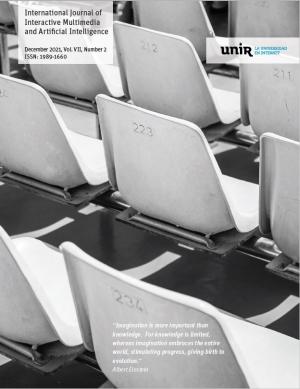Extensive Classification of Visual Art Paintings for Enhancing Education System using Hybrid SVM-ANN with Sparse Metric Learning based on Kernel Regression.
DOI:
https://doi.org/10.9781/ijimai.2021.10.001Keywords:
Support Vector Machine, Human-Computer Interaction (HCI), Artificial Neural Networks, Sparse Metric Learning, Feature Extraction, Machine Learning, Visual Arts Education, Digitalization of PaintingsAbstract
In recent decades, the collection of visual art paintings is large, digitized, and available for public uses that are rapidly growing. The development of multi-media systems is needed due to the huge amount of digitized artwork collections for retrieving and archiving this large-scale data. This multimedia system benefits from high-level tasks and has an essential step for measuring the similarity of visual between the artistic items. For modeling the similarities between the artworks or paintings, it is essential to extract useful features of visual paintings and propose the best approach for learning these similarity metrics. The infield of visual arts education, knowing the similarities and features, makes education more attractive by enhancing cognitive development in students. In this paper, the detailed visual features are listed, and the similarity measurement between the paintings is optimized by the Sparse Metric Learning-based Kernel Regression (KR-SML). A classification model is developed using hybrid SVM-ANN for semantic-level understanding to predict painting’s genre, artist, and style. Furthermore, the Human-Computer Interaction (HCI) based formulation model is built to analyze the proposed technique. The simulation results show that the proposed model is better in terms of performance than other existing techniques.
Downloads
References
A. E. Abdel-Hakim and A.A. Farag, “CSIFT: A SIFT descriptor with color invariant characteristics”. In 2006 IEEE Computer Society Conference on Computer Vision and Pattern Recognition (CVPR’06) Vol. 2, 2006, June, pp. 1978-1983. IEEE.
R. Arnheim, “A plea for visual thinking,” New essays on the psychology of art. University of California Press, 1986, pp. 135-152.
T. P. Beebe, Z. Voras, K. de Gheraldi and J. Mass, “Surface Analysis of Fine Art Paintings: Studying Degradation Mechanisms with a Systematic Approach,” Microscopy and Microanalysis, vol. 24, no. S1, 2018, pp. 1050-1053.
S.H. Zhong, X. Huang and Z. Xiao, “Fine-art painting classification via two-channel dual path networks,” International Journal of Machine Learning and Cybernetics, 2019, pp. 1-16.
O. Kelek, N. Calik and T. Yildirim, “Painter Classification Over the Novel Art Painting Data Set via The Latest Deep Neural Networks,” Procedia Computer Science, no. 154, 2019, pp. 369-376.
A. Paul and C. Malathy, “An Innovative Approach for Automatic Genre-Based Fine Art Painting Classification,” In Advanced Computational and Communication Paradigms, Springer, Singapore, 2018, pp. 19-27.
E. Ohno, “State of the Fine art in the age of artificial intelligence,” 2019, pp. 175-175.
Y. Deng, F. Tang, W. Dong, F. Wu, O. Deussen, and C. Xu. ”Selective clustering for representative paintings selection, ”Multimedia Tools and Applications, 2019, pp. 1-19.
T.E. Lombardi, “The classification of style in fine-art painting,” Pace University,2005.
R.S. Arora, and A. Elgammal, “Towards automated classification of fine-art painting style: A comparative study,” In Proceedings of the 21st International Conference on Pattern Recognition, 2012, pp. 3541-3544.
G. Carneiro. N. P. da Silva, A. Del Bue and J. P. Costeira, “Artistic image classification: An analysis on the print art database,” In European Conference on Computer Vision, Springer, Berlin, Heidelberg, 2012, pp. 143-157.
B. Saleh, K. Abe and A. M. Elgammal, “Knowledge Discovery of Artistic Influences: A Metric Learning Approach,” In ICCC, 2014, pp. 163-172.
Y. Bar, N. Levy and L. Wolf, “Classification of artistic styles using binarized features derived from a deep neural network,” In European conference on computer vision, Springer, Cham, 2014, pp. 71-84.
H. Takeda, S. Farsiu, and P. Milanfar, “Robust kernel regression for restoration and reconstruction of images from sparse noisy data,” In 2006 International Conference on Image Processing, 2006, pp. 1257-1260.
S. Karayev, M. Trentacoste, H. Han, A. Agarwala, T. Darrell, A. Hertzmann and H. Winnemoeller, “Recognizing image style,” arXiv preprint arXiv:1311.3715, 2013.
N. S. Murugan and G. U. Devi, “Detecting streaming of Twitter spam using hybrid method,” Wireless Personal Communications, vol. 103, no. 2, 2018, pp. 1353-1374.
N. S. Murugan, and G. U. Devi, “Feature extraction using LR-PCA hybridization on twitter data and classification accuracy using machine learning algorithms,” Cluster Computing, 2018, pp. 1 3965-13974.
N.S. Murugan, and G.U. Devi, “Detecting spams in social networks using ML algorithms-a review,” International Journal of Environment and Waste Management, vol.21, no.1, 2018, pp. 22-36.
G. Manogaran, C. Thota, and D. Lopez, “Human-computer interaction with big data analytics,” In HCI challenges and privacy preservation in big data security,2018, pp. 1-22, IGI Global.
Y. Bar, N. Levy, and L. Wolf, “Classification of artistic styles using binarized features derived from a deep neural network,” In European conference on computer vision, 2014, pp. 71-84, Springer, Cham. A.
Oliva, and A. Torralba, “Modeling the shape of the scene: A holistic representation of the spatial envelope,” International journal of computer vision, vol.42, no. 3, 2001, pp. 145-175.
L. Torresani, M. Szummer, and A. Fitzgibbon, “Efficient object category recognition using classemes,” In European conference on computer vision, 2010, pp. 776-789, Springer, Berlin, Heidelberg.
A. Vedaldi, and K. Lenc, “Matconvnet: Convolutional neural networks for matlab,” In Proceedings of the 23rd ACM international conference on Multimedia, 2015, pp. 689-692.
A. Prathik, J. Anuradha, and K. Uma, “A Novel Algorithm for Soil Image Segmentation using Colour and Region Based System,” International Journal of Innovative Technology and Exploring Engineering, 2019, vol. 8, no. 10, pp. 3544-3550.
Z. Duric, W.D. Gray, R. Heishman, F. Li, A. Rosenfeld, M.J. Schoelles, C. Schunn, and H. Wechsler, “Integrating perceptual and cognitive modeling for adaptive and intelligent human-computer interaction,” Proceedings of the IEEE, 2002, vol. 90, no. 7, pp.1272-1289.
C. Cedras and M. Shah, “Motion-based recognition a survey”, Image and vision computing, vol. 13, no. 2, 1995, pp. 129-155.
R. Peterson, “Crossing Bridges That Connect the Arts, Cognitive Development, and the Brain,” Journal for Learning through the Arts, Vol. 1, no. 1, 2005, pp. 2.
E. Gredler Margaret and c.c. Shields. “Vygotsky’s legacy: A foundation for research and practice”. Guilford Press, 2008.
Downloads
Published
-
Abstract168
-
PDF41









